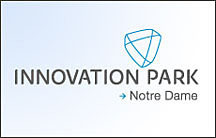
Another significant milestone in the University of Notre Dames continuing quest to become a preeminent research university, as well as a new chapter in the collaboration between the University, state and local officials and the business community was celebrated Friday (Sept. 26) during groundbreaking ceremonies for Innovation Park at Notre Dame.
More than 200 local and regional guests gathered for the event at the parks future site near the corner of Twyckenham Drive and Edison Road in South Bend. University Provost Thomas G. Burish hosted the event and speakers included Indiana Lt. Gov. Becky Skillman, South Bend Mayor Steve Luecke and David Brenner, president and chief executive officer of Innovation Park.
To be located on 12 acres of land adjacent to the south side of the University, Innovation Park will be home to a variety of start-up businesses, including expected commercial applications from the new Notre Dame-based Midwest Institute for Nanoelectronics Discovery (MIND), othercore University research areas, and from other potential clients not affiliated with the University.
Our vision for this park is very clear,Burish said.It will become a key transformational phase in moving research concepts from theory to practical application in the marketplace, in fields such as aerospace, life sciences, the environment and other fields. It will also provide new, innovative experiential learning opportunities for our students from all colleges.
During her remarks, Skillman announced that Innovation Park has been approved as a state-certified research park. Certified technology parks are allowed to capture up to $5 million in payroll and sales taxes generated in the park. A $2 million state grant also is helping with construction costs of the park.
Im so delighted to be here today and proud to celebrate a great opportunity for all Hoosiers and for South Bend,Skillman said.Todays announcement represents economic development at its finest through a partnership between government, the university and private entities.
The parks first building, to be completed by fall 2009, will be a three-story, 54,000-square-foot structure that will include collaborative areas, conference rooms, administrative offices, incubation facilities and lab space. Plans are being developed for future expansions.
For example, University and city of South Bend officials anticipate that once nanoelectronics businesses emerge from their Innovation Park start-up phase, they will move to a nanoelectronic development facility the city is creating in the former Studebaker corridor just south of the downtown area.
Innovation Park will be a crucial economic driver for this region, building on our strong history of innovation and entrepreneurship,Mayor Luecke said.It connects town and gown in a vital way that reinforces the strong partnerships that already have produced the nearby $215-million Eddy Street Commons development. Innovation Park at Notre Dame will be a center for creativity and a meeting place for innovators in the greater South Bend area.
A sign at the Innovation Park site reads:Connect, Collaborate, Commercialize.During his remarks, Brenner explained its meaning.
This park is designed to be a transformational space, to help convert theoretical ideas into viable commercial enterprises,he said.To make this happen requires connecting innovative ideas and research being pursued here at the University or elsewhere with private sector experts who have been there, done that and can help guide the new venture by collaborating to explore various pathways to the market.
In a larger sense, the park serves as a bridge to the futureby transforming the hidden potential of new innovative ideas into viable new business opportunities with growth potential beyond the immediate footprint of these 12 acres.
_ Contact: David Brenner, Innovation Park president and chief executive officer, 574-631-8825,_ " David.H.Brenner.16@nd.edu ":mailto:David.H.Brenner.16@nd.edu
TopicID: 29650